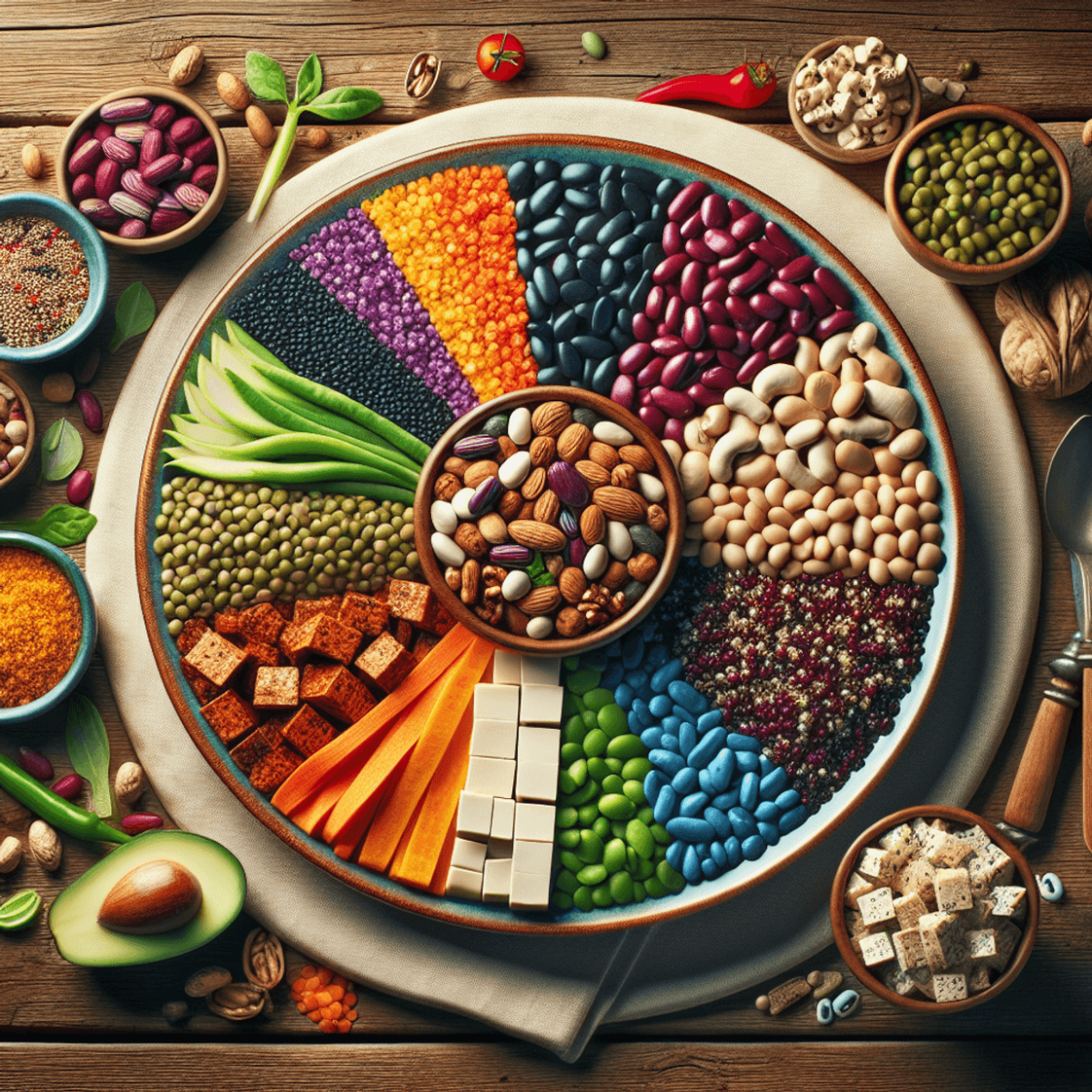Introduction
Meeting your dietary needs as a vegetarian or vegan is crucial, with protein being a key nutrient. Protein is essential for muscle repair, immune function, and overall health. Yet, there’s a common misconception that vegetarians and vegans struggle to get enough protein.
Some believe plant-based diets lack sufficient protein sources. This article dispels these myths by exploring the top protein sources for vegetarians and vegans. You’ll discover how to incorporate these protein-rich foods into your meals effectively.
Understanding Protein Requirements
Recommended daily protein intake for adults varies but generally falls around 46 grams for women and 56 grams for men. These numbers are influenced by factors such as age, activity level, and overall health.
Complete proteins are crucial because they contain all nine essential amino acids our bodies cannot produce. While animal products naturally offer complete proteins, many plant-based sources do not. Hence, vegetarians and vegans need to be mindful of combining different protein sources to ensure they get a well-rounded intake of essential amino acids.
Meeting protein needs on a plant-based diet can be seamlessly achieved by incorporating a variety of protein-rich foods:
- Legumes like lentils and beans
- Nuts and seeds
- Soy products such as tofu and tempeh
- Whole grains like quinoa
By diversifying your diet with these options, you can easily fulfill your daily protein requirements without relying on animal products.
Top Protein Sources for Vegetarians and Vegans
1. Seitan: The Meat-Like Wonder Source of Protein for Vegans and Vegetarians!
Nutritional Profile of Seitan
Seitan, often referred to as wheat meat or wheat gluten, is a powerhouse of plant-based protein. With approximately 25 grams of protein per 100 grams, it stands out for its high protein content. This versatile ingredient is also low in fat, making it a healthy addition to your diet.
Benefits of Incorporating Seitan into Your Meals
- Versatility: Seitan’s ability to mimic the texture of meat makes it a favorite among vegetarians and vegans. You can use it in various cuisines, from Asian stir-fries to Western-style sandwiches.
- Nutrient-Rich: Besides being high in protein, seitan is rich in minerals like selenium, iron, calcium, and phosphorus.
- Satiating: Its dense texture provides a satisfying chewiness that can make meatless meals more filling.
Cooking Tips for Achieving the Best Flavor and Texture with Seitan
- Marinate Well: To enhance its flavor, marinate seitan before cooking. Use soy sauce, garlic, ginger, and other spices to infuse it with taste.
- Cook Properly: Whether you grill, bake, or stir-fry seitan, ensure it’s cooked thoroughly to achieve the best texture. Avoid overcooking to keep it tender.
- Pair with Bold Flavors: Seitan pairs well with bold sauces like BBQ or teriyaki. These flavors complement its natural taste and enhance your dish.
Delicious Recipe Ideas
- BBQ Seitan Sandwiches: Marinate seitan strips in BBQ sauce and grill them until they are slightly charred. Serve on whole-grain buns with coleslaw for a delicious sandwich.
- Stir-Fried Seitan with Vegetables: Slice seitan thinly and stir-fry with bell peppers, onions, broccoli, and your favorite stir-fry sauce for a quick and nutritious meal.
Exploring seitan’s potential in your meals not only boosts your protein intake but also adds variety and excitement to your culinary repertoire.
2. Tofu and Tempeh: Soy Superstars Packed with Protein!
Tofu and tempeh, derived from soybeans, are essential protein sources for vegetarians and vegans. While tofu is known for its smooth texture, tempeh offers a nuttier taste due to the fermentation process it undergoes.
Nutritional Comparison
Here’s how tofu and tempeh stack up nutritionally:
| Nutrient | Tofu (per 100g) | Tempeh (per cup) |
|---|---|---|
| Protein | 12-20 grams | 33.7 grams |
| Amino Acids | Complete | Complete |
| Fiber | – | Richer than tofu |
Ways to Enjoy Tofu and Tempeh
Both these soy products can be incorporated into various meals:
- Scrambles: Use crumbled tofu as a base for a vegan scramble.
- Marinated Skewers: Marinate tempeh chunks and grill them for delicious skewers.
- Stir-fries: Add tofu or tempeh to vegetable stir-fries.
- Baked Dishes: Bake marinated tofu or tempeh for a savory entrée.
Experimenting with different marinades and cooking methods can enhance their natural flavors, making them versatile additions to your diet.
3. Lentils: Tiny Powerhouses of Plant-Based Protein!
Lentils are a staple in vegetarian and vegan diets, offering around 18 grams of protein per cooked cup. These legumes come in various types, each with unique flavors and cooking times:
- Red Lentils: Cook quickly and are ideal for soups and stews thanks to their smooth texture.
- Green Lentils: Hold their shape well, making them perfect for salads and side dishes.
- Black Lentils: Also known as beluga lentils, these have a robust flavor and firm texture, suitable for hearty dishes.
Beyond their protein content, lentils are high in fiber, which supports digestive health. They also provide essential nutrients like iron and manganese.
Benefits of Lentils
- High Fiber: Promotes digestive health.
- Nutrient-Dense: Rich in iron and manganese.
- Versatile: Suitable for soups, salads, and main dishes.
For a delicious way to incorporate lentils into your meals, try a classic lentil soup or a refreshing green lentil salad.
4. Beans: Versatile Legumes That Pack a Protein Punch!
Beans are an excellent protein source, providing around 15 grams of protein per cooked cup. Popular types include:
- Kidney Beans: Known for their hearty texture and slightly sweet flavor, ideal for chili and stews.
- Black Beans: Packed with nutrients and offering a rich, earthy taste, perfect for soups and burritos.
- Chickpeas: Also called garbanzo beans, these legumes have a nutty taste and creamy texture, great for hummus or salads.
Incorporating beans into your diet can be simple:
- Soups: Add kidney beans to vegetable soups for added protein.
- Salads: Toss chickpeas into mixed greens for a nutrient boost.
- Veggie Burgers: Mash black beans with spices to create delicious homemade patties.
Beans are versatile enough to fit into various recipes, making them a staple in plant-based diets.
5. Nuts & Seeds: Crunchy Delights with Added Protein Benefits!
Nuts and seeds are excellent sources of protein, offering both variety and convenience. Different types such as almonds, chia seeds, and pumpkin seeds can significantly contribute to your daily protein intake. For instance:
- Almonds: Around 6 grams of protein per ounce.
- Chia Seeds: Approximately 5 grams of protein per ounce.
- Pumpkin Seeds: About 7 grams of protein per ounce.
These foods not only provide protein but also essential fatty acids, fiber, and a range of vitamins and minerals.
Creative ways to incorporate nuts and seeds into your meals include:
- Trail Mixes: Combine different nuts, seeds, and dried fruits for a nutritious snack.
- Nut Butter Spreads: Use almond or peanut butter on toast, in smoothies, or as a dip for fruits.
- Salad Toppings: Add crunch by sprinkling sunflower seeds or chopped walnuts on salads.
- Baking: Integrate flaxseeds or chia seeds into bread, muffins, or energy bars.
Experimenting with these options can make your diet more varied and enjoyable while ensuring you meet your protein needs.
6. Quinoa: A Complete Grain That Goes Beyond Just Carbs!
Quinoa stands out among grains because it is a complete protein source, containing all essential amino acids our bodies need. This makes it an exceptional choice for vegetarians and vegans looking to meet their protein requirements.
To cook perfect fluffy quinoa, follow these steps:
- Rinse quinoa under cold water to remove its natural coating, which can taste bitter.
- Use a 1:2 ratio of quinoa to water or broth.
- Bring the mixture to a boil, then reduce the heat to low and cover.
- Simmer for about 15 minutes until the liquid is absorbed.
- Let it stand covered for 5 minutes, then fluff with a fork.
Here are some delicious ways to enjoy quinoa:
- Quinoa Salad: Mix cooked quinoa with chopped vegetables, nuts, seeds, and a flavorful dressing.
- Stuffed Peppers: Fill bell peppers with a mixture of quinoa, beans, and your favorite spices before baking.
Experimenting with different recipes ensures you never get bored while benefiting from this nutritious grain.
7. Nutritional Yeast: Cheesy Flavor Bombs Packed With Nutrients!
Nutritional yeast, often referred to as “nooch,” is made from deactivated yeast flakes enriched with essential vitamins and minerals, including B12, which is crucial for strict vegan diets. It’s a powerhouse of nutrients and offers a savory, cheese-like flavor making it an excellent addition to various dishes.
Incorporating nutritional yeast into your meals:
- Sprinkling over popcorn: A simple way to enjoy its cheesy taste while adding a nutrient boost.
- Blending into sauces: Create creamy, dairy-free sauces by mixing nooch with cashews or silken tofu.
- Using in pasta dishes: Sprinkle it over pasta or stir it into your favorite mac and cheese recipe for added depth and nutrition.
By incorporating nutritional yeast, you can enhance the flavor profile of everyday meals while ensuring you’re getting vital nutrients that support overall health.
8. Edamame: Young Soybeans That Are Both Delicious And Nutritious!
Edamame stands out as a potent source of plant-based protein, offering approximately 11 grams of protein per half-cup serving. Beyond its impressive protein content, edamame is rich in antioxidants, fiber, and essential vitamins such as vitamin K and folate.
Preparation methods:
- Steamed Plain: A quick and simple way to enjoy edamame is by steaming the pods until tender. Sprinkle with a touch of sea salt for a natural flavor boost.
- Seasoned: Toss steamed edamame with spices or seasonings like garlic powder, chili flakes, or sesame oil for an added kick.
Edamame recipes:
- Edamame Hummus: Blend edamame with tahini, lemon juice, garlic, and olive oil for a protein-packed dip.
- Edamame Salad: Combine shelled edamame with quinoa, cherry tomatoes, cucumber, and a light vinaigrette for a refreshing salad.
Including edamame in your diet not only diversifies your protein sources but also adds a delicious and nutritious element to your meals.
9. Chia Seeds & Spirulina: Nature’s Superfood Duo For Veggie Lovers!
Exploring lesser-known yet highly nutritious options like chia seeds and spirulina can elevate your plant-based protein game.
1. Chia Seeds
These tiny seeds are packed with approximately 5 grams of protein per ounce. Their gelatinous texture makes them perfect for enhancing smoothies, puddings, and baked goods. They are also rich in omega-3 fatty acids and fiber.
Recipe Idea: Try a chia seed pudding by soaking chia seeds in almond milk overnight, then topping with fresh fruits and nuts.
2. Spirulina
This blue-green algae offers around 8 grams of complete protein per two tablespoons. Its vibrant color and nutrient density make it an excellent addition to smoothies and energy bars.
Recipe Idea: Blend spirulina into a smoothie with bananas, spinach, and pineapple for a nutrient-packed green drink.
These superfoods not only boost your protein intake but also offer various health benefits, fitting seamlessly into a vegetarian or vegan diet.
Combining Plant-Based Proteins For Complete Nutrition Balance In Your Diet!
Achieving complete nutrition on a plant-based diet involves combining different protein sources to ensure you get all essential amino acids. This concept, known as complementary proteins, is vital because relying solely on one type might lead to deficiencies. For instance, grains often lack lysine, an essential amino acid.
Effective Combinations:
- Rice and Beans: A classic duo that provides all essential amino acids.
- Hummus and Whole Grain Bread: A tasty combo that ensures a complete protein profile.
- Quinoa and Lentils: Both are strong protein sources that complement each other well.
By mixing various plant-based foods, you can easily meet your nutritional needs.



